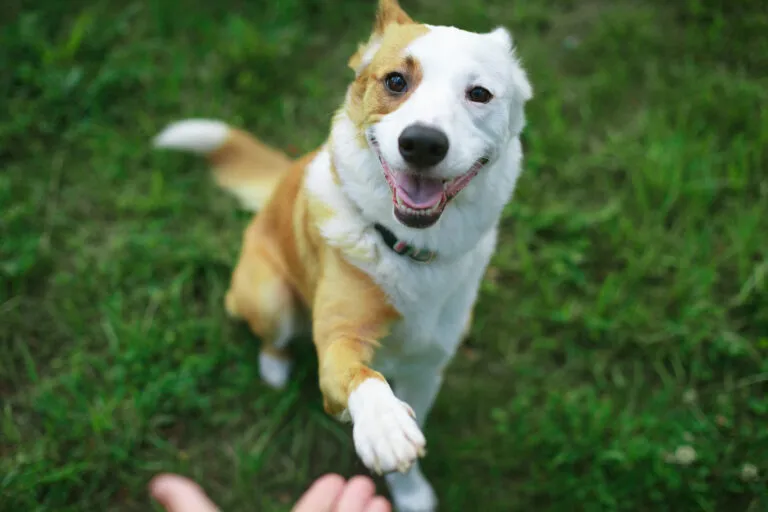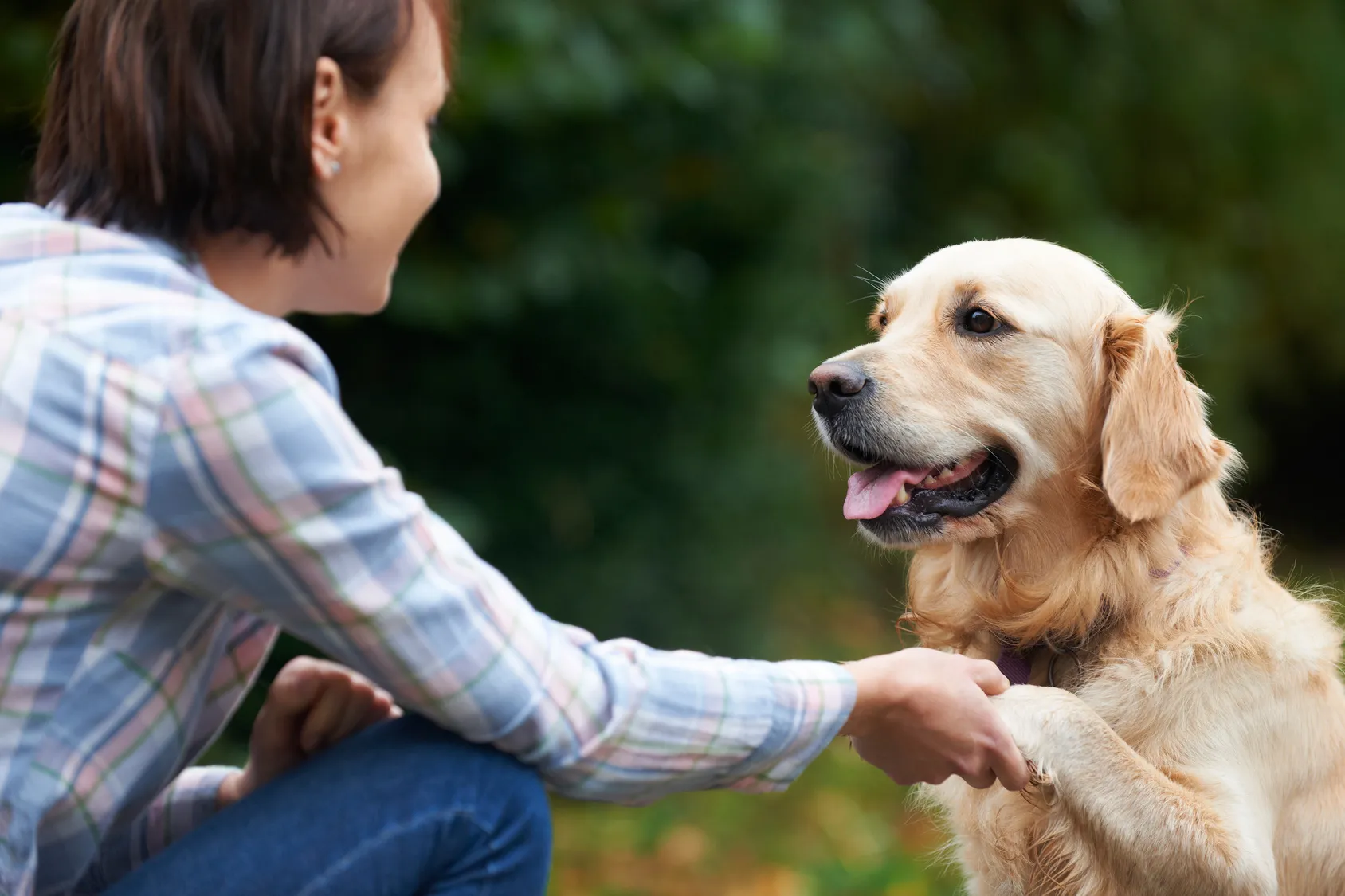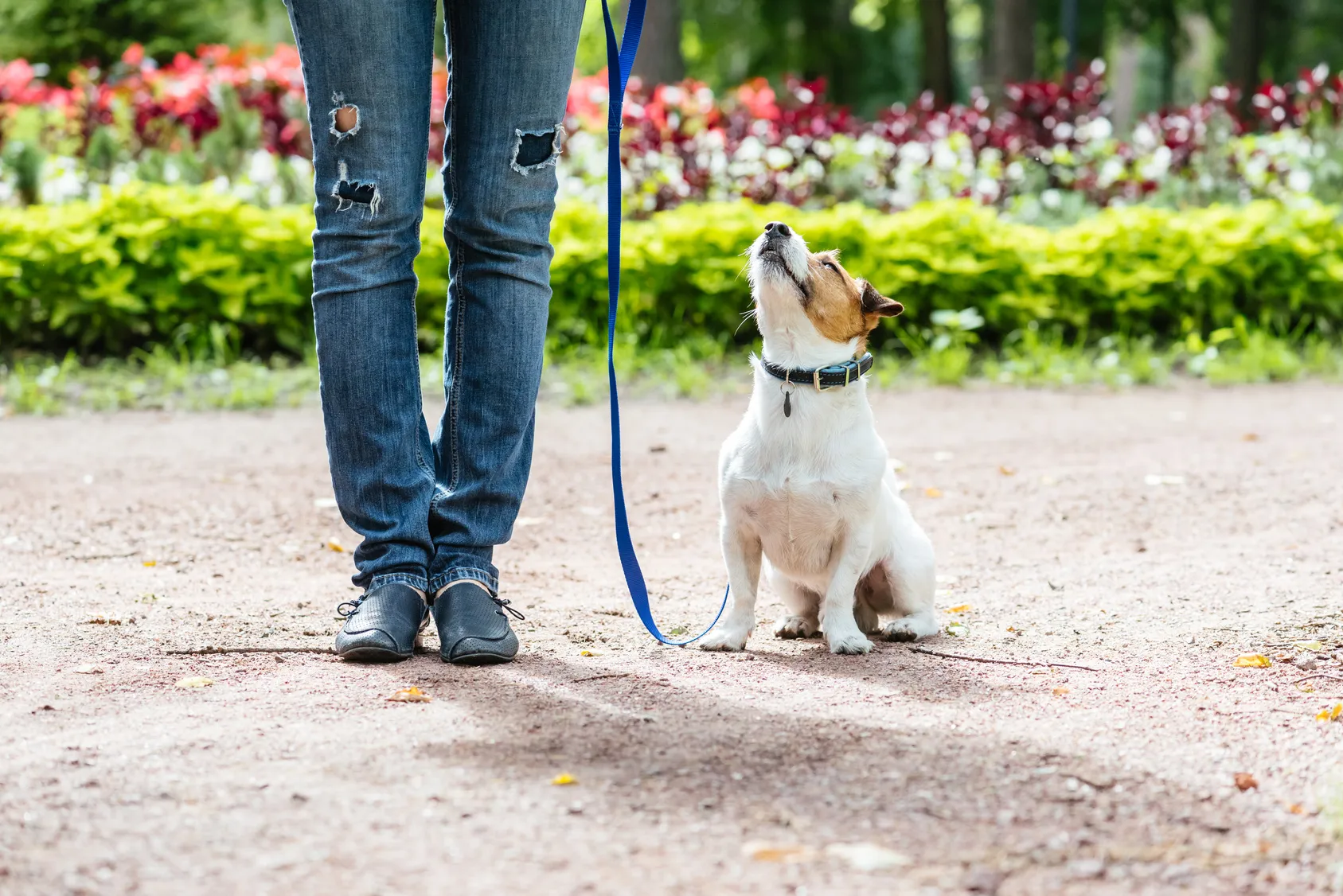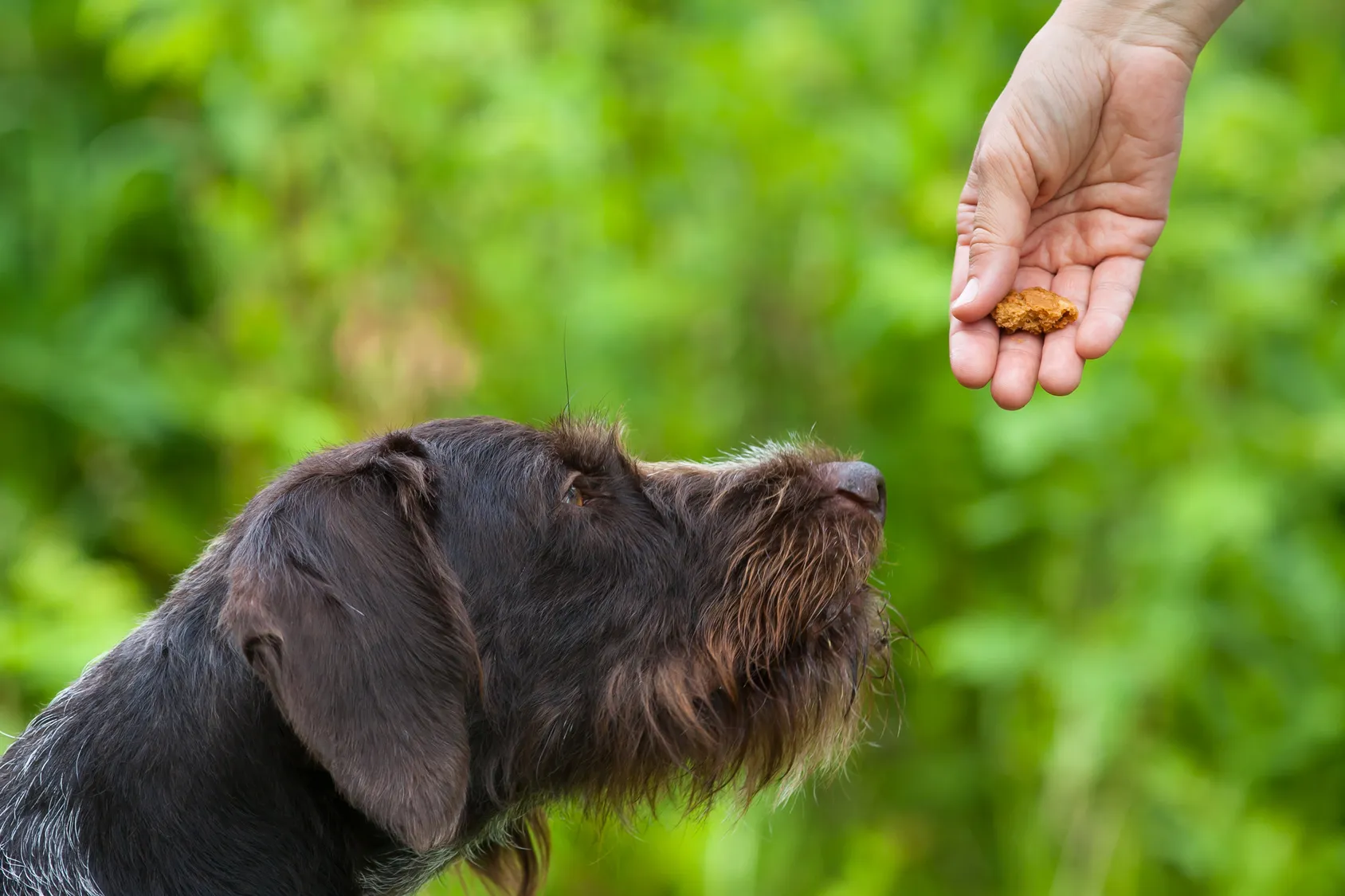Development of Puppies: From Birth to Adulthood
Every puppy goes through several developmental phases until it eventually grows into an adult dog. Learn more what is crucial for the development of puppies into self-assured and serene dogs.
The earlier you train your dog, the less problems they will cause later on. However, training adult dogs basic commands is still possible.

We will show you what you should consider when training your adult dog and which seven exercises are perfect for beginners.
Dogs are intelligent animals and never stop learning. They are able to grasp commands, rules and certain modes of behaviour well into old age – just as they are still capable of acquiring undesirable behaviours. Hence, their training should never stop. Otherwise, your dog can forget the most rigorous training. Commands that have been taught once have to be maintained for an entire lifetime.
Young dogs are easier to mould since they are very inquisitive, learn a lot by playing, and still have an impartial view of the world. A great advantage for puppy training. However, a puppy can still take more time than training an adult dog as they need to learn the most basic behaviours such as toilet training and socialisation.
Training adult dog can also have its advantages. Older dogs are generally calmer in their behaviour and more stable than young dogs. They are house-trained and can mostly be left alone. Consequently, they are already used to a more of less fixed daily rhythm of sleeping, eating and going for walks. It’s already possible to take them for longer walks and when it comes to exercises too. Adult dogs need less breaks than playful puppies that can soon become overwhelmed.
 © highwaystarz / stock.adobe.com
© highwaystarz / stock.adobe.com
A disadvantage of training adult dogs is mostly that certain behaviour have become ingrained often leading to stubborness. Changing behaviour that has once been learnt is quite demanding and therefore requires consistency and patience from the owner. The question isn’t whether adult dogs can still be trained, but rather when they will permanently put into practice what they have learnt. An adult dog can be trained just like a young dog – but it may take longer.
If you wish to train dogs that have already developed severe behavioural problems, a great deal of patience is required. Before you start to tackle these with targeted training, you must first investigate the cause. Why is the dog destructive? What’s behind the aggression? It can be due to psychological disorders triggered by traumatic experiences or chronic pain, but also by permanent stress, being kept in isolation or a lack of physical and mental stimulation. The better you know the causes of your dog’s behaviour, the greater the possibility of establishing promising and targeted training. First-time dog owners in particular should definitely make use of the help of an expert. Although a discussion with a dog trainer and attending a dog school can be useful for experienced people too.
In order for cohabitation between humans and dogs to work, certain rules are necessary. No other animal is as bonded to humans as dogs. They might even be genetically predisposed to be our most loyal companions. However, dogs still carry some traits from their wolf ancestors. This means, they demand a specific order in their “pack” that provides them with security and orientation. Dogs need clear rules that can be adhered to consistently. Every exception to these rules unsettles them, enticing self-confident breeds in particular to take the reigns themselves.
To avoid conflicts, your dog must master basic commands like “sit”, “stay”, “drop” and “heel”. The following exercises are a basic framework that your dog should master and that will make both your life and that of your dog and surroundings more straightforward.
Training should be tailored to your dog’s age. You can take advantage of a puppy’s playfulness, but should consider their short attention span. Grown dogs often need more incentives and challenges to stay interested. Adult dogs have already developed fixed preferences. The better you know your dog, the better you can make use of said preferences for training. Dog training works best with positive reinforcement. If you know what your dog likes, you can reward it as soon as it has shown the desired behaviour. This doesn’t always have to be treats – try stroking, offering words of praise, a toy or a game of fetch.
Walking comfortably is probably one of the most important skills. They must learn to ignore humans and other animals when they are on a lead and not to pull you in a certain direction. Once an adult dog has learnt that it advances when it pulls hard enough on the lead, it will keep doing so. However, you can break its habit of pulling with a bit of know-how and above all plenty of patience and consistency. In order for your dog to reject the pattern of behaviour it has already learnt, try to change the situation. For instance, if it had a collar up until now, change this to a harness immediately. If it pulls with both and there is no point switching from a harness to a collar or vice versa, you can also fix the lead to a towel and put it on your dog. Your dog should become aware of this change and letting it sniff it out extensively beforehand. In this way, it will be willing to engage with something new.
If you start a walk and your dog immediately pulls at the lead once again, stand still. Only continue when your dog comes closer again and the lead becomes looser. As soon as they starts pulling again, stop once again and consistently maintain this pattern. If your dog pulls very strongly on the lead and you have to exert yourself to prevent it from advancing, invite them to come to you with an audio signal or through your body language. Another exercise is placing a treat or sought-after toy some distance away (around 20m) on a clearly visible spot on the route. Your dog will presumably want to pounce on it right away, but hold it back and give it the command to come to you. As soon as it turns around, take a few steps back and show your dog that the only way forward is in your direction. Only approach the desired object when your dog manages to stand alongside you on a loose lead. Thus, it only receives the treat when it has learnt to restrain itself and follow your tempo.
Treats can be very useful in order to teach your dog to sit when it hears the “sit” command. Hold the treat far above your dog’s head. If they attempt to jump up for the treat, your hand remains closed. Your dog will soon sit down in order to better see the treat above their head. As soon as the rear end and front paws are on the ground, say “sit” and give your dog the much-anticipated treat. Praise them with kind words or by stroking it.
 © alexei_tm / stock.adobe.com
© alexei_tm / stock.adobe.com
After a few exercises, your dog will have learnt to sit when they hears the word “sit” – before you use a treat to cajole it. In order to practise sitting still for longer periods, you can extend the time until you give the treat. You can easily integrate practising the “sit” command into day-to-day life.
With the “here” command (or a similar whistle), your dog should stop running immediately and quickly come to you. At the beginning, you of course cannot let adult dogs that haven’t yet learnt to listen to a similar command run freely off the lead.
Hence, first of all practise “here” in your home, ideally connecting this to your dog’s meal time. It is helpful for someone else to hold your dog back whilst you prepare their food. Make sure this is visible to your pooch. As soon as you call out “here”, your dog should be let free. If they come to you, praise them effusively and place their food bowl on the floor. The following times when your dog comes to you immediately when calling out “here”, reward them with a tasty treat and show your appreciation.
Only when your dog reliably comes to you on your signal can you take them on a walk off its lead and practise the exercise. Ideally, at first choose a solitary spot where if possible you won’t encounter any other dogs that could distract them. Alternatively, you can carry out this exercise very early in the morning or very late in the evening when there aren’t many people around. Only give your dog the “here” command if you are sure that they will obey. If you see other dogs, put your dog’s lead back on and only carry out the exercise when the other dog is out of sight.
It’s also advisable to practise the “here” command using your dog’s name as that’s usually what owners call out in stressful situations.
Outside, there are many situations which require your dog to stay close. This can be heavy traffic or busy pedestrian zones. In these cases, the “heel” command comes in handy. It should ensure that your companion stays close to you when walking or even standing still. Traditionally dogs are led on the left side, but you can get them used to walking on your right if you prefer. The important thing is to stick to the chosen side. Begin the exercise by showing your dog where “heel” is using a tasty treat. As soon as they have assumed the correct position, say “heel”.
Hold the treat in your hand and let your dog lick it whilst you set off. As an additional visual signal, you should occasionally clap your thigh with the same hand. After a few metres, say “sit” and reward your dog. Make the exercise more difficult by building in more and more challenges such as changing in direction. Gradually, you should also lead the treat away from your dog’s snout. For instance, hide the treat in your pocket and continue to practise the “heel” command. Go slower, faster, left, right, forwards, backwards and occasionally repeat “heel”, along with the corresponding visual signal. You can only practice the exercise off the lead when your dog can be relied upon to stay by your side. If your dog moves away from your side after removing its lead, don’t pull it back by its collar and instead calmly put its lead on again and repeat the training exercise.
When hearing the “drop” command, your dog should let go of a certain thing or object. For instance, if your dog has grabbed onto a shoe or “bitten” one of your children’s toys, you should let it know through a clear “drop” command that you are not happy with this.
 © rodimovpavel / stock.adobe.com
© rodimovpavel / stock.adobe.com
In order for an adult dog to react to your command, you must tempt it with a different object, such as a treat or dog toy. In other words, you have to offer it something in exchange. Hold the treat before their nose and say “drop”. As soon as they open their snout and let go of the other object, give them the treat along with petting and praising. Gradually you can leave the treat or toy to one side and only reward your dog for successfully obeying the “drop” command with kind words and by petting.
Dogs have to learn to sit in a certain spot or to stay lying down. Your dog should obey your “sit and stay” command not just outside the supermarket, but also when the doorbell rings or visitors call by who are scared of dogs. First of all, it has to master both the “sit” and “stay” commands. If your dog can calmly stand or lie by your side upon command, you can start practising “stay”.
Give your dog a signal (for example, point to the floor with the palm of your hand) and clearly say “stay”. Now stand in front of your dog and move away just far enough for the lead between you to hang loosely. Stay still for a brief moment and return to them. If your dog remains sitting or lying down, offer them effusive praise. If you reward your dog with a treat, it should only be when they has come back to you or stayed sitting or lying down. Even if they have waited dutifully and only jumped up at the last moment, don’t give them a reward. If you were to do so, they would associate this with jumping up rather than staying. You can practise the exercise with a longer lead at the beginning and without a lead at a later stage. You should also gradually lengthen the duration of time the “stay” command should be observed.
Training adult dogs requires both plenty of time and a huge amount of discipline. Above all, dog owners need patience and perseverance along with consistency and intuition. Particularly if the dog has already demonstrated difficult behaviour. Don’t be disheartened if things don’t work out straight away. It takes a while for a dog to go along with alternative behaviour and grasp that it’s worth obeying your commands. Regularly attending a dog school can be a good motivational incentive. Discussions with experts and other dog owners are often very informative, especially if it’s your first dog. It’s important that the approach of the dog school is right for you and your dog. The groups shouldn’t be too big so that the trainer can focus on each individual dog (and owner) and gladly answer all questions.
Every puppy goes through several developmental phases until it eventually grows into an adult dog. Learn more what is crucial for the development of puppies into self-assured and serene dogs.
Some dog lovers are sure that their canine companion understands them perfectly. Nevertheless, there are often misunderstandings between humans and dogs in day-to-day life, because what appears self-explanatory to us isn't always so clear for dogs. What do dogs really understand?
Many dog owners kiss their dogs and cats, so we can only hope that they have brushed their own teeth and their pet's too! But joking aside – cuddling and snuggling with animals isn't just unhygienic in certain cases, but can also be dangerous.